USDC & Stable Coins
Stable coins: the big winners of the 2020-2021 crypto bull cycle. Well, perhaps expect algorithmic stable coin Terra who collapsed on March 7, 2022.
But USD Coin (USDC), USD Tether (USDT), Binance USD (BUSD), and many more saw an incredible growth in their transaction volume during the crypto bull run. USDC supply grew over 8300% from 2020-2021, going from a total supply of $0,5 billion at the start of 2020 to an crazy $40 billion in 2021.
USDC, USDT, and BUSD are currently at #3, 5, and 7 of total market capitalization, according to Coinmarketcap.
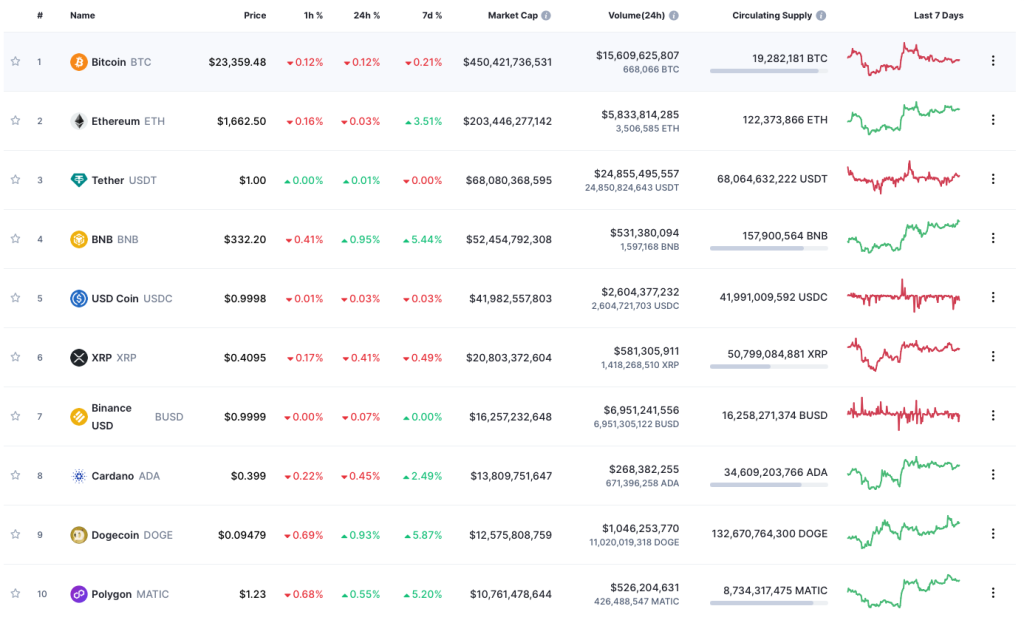
In this article, I will dive into USDC and its goals for the year 2023 and beyond. Among the stable coins raking in the top 10 in terms of market capitalization, USDC stands out as being primarily focused on facilitating real-world transactions, serving as a foundational layers for a decentralized, internet-based economy. On the other hand, USDT and BUSD are mainly utilized for exchange liquidity in financial transactions. This is evidenced by the fact that 70% of their total supply is kept as liquidity on exchange platforms, compared to less than 10% of USDC’s total supply.
USDC Issuer: Circle
Circle Internet Financial Inc., located in Boston, Massachusetts, is the tech company responsible for both USD Coin (USDC) and the recently introduced EURO Coin (EUROC).
Circle was founded in 2013 by Jeremy Allaire, who remains its active CEO. The company’s initial objective was to integrate Bitcoin payments into the conventional financial framework. Jeremy aims to expand Circle and its technology infrastructure into the core layers of the new financial system.
The development of stable coins came later, with USDC being launched in 2018 during the crypto winter, when crypto demand was at its historical low, and there was even less demand for crypto stable coins. As previously mentioned, the situation changed during the crypto bull market of 2020-2021, causing USDC’s supply to surge by an incredible 8300% to nearly $40 billion. Currently, USDC ranks as the 5th largest crypto project globally.
Current USDC Market
The trend towards a cashless society has been accelerated by the recent drop in cash usage and the pandemic, with countries like the Nordics leading the way. This shift has been taken advantage of by Circle, with the rise of stable coins as the first type of internet-based money that can be sent anywhere in the world with a smooth checkout process. The first stable coin was USD Tether (USDT), founded in 2014.
More Room For Growth
Despite the growth of stable coins during the 2020-2021 bull run, there is still much room for growth. USDC in circulation is under 2% of the total USD in the economy and mobile payments are predicted to increase by 221% over the next five years. The main use case for USDC is cross-border remittances and value transfer through the blockchain, which Circle sees as the best option for now.
In 2022, USDC facilitated $4.5 trillion worth of transactions on the Ethereum blockchain, with 60% of these transactions being related to smart contracts. USDC is powering a rapidly growing decentralized finance ecosystem, including lending pools and automated market making, and is being used for more general transactions instead of just financial transactions. 15% of USDC transactions are wallet-to-wallet, showing its potential to tackle financial inclusion challenges.
USDC Uncorrelated To Trading Volumes
The growth of USDC issuance is not tied to the crypto market as we can see from the figure below comparing USDC growth to spot trading volumes. Its transactions are more tangible and supportive of economic activities. USDC has a 10% speculative ratio compared to 70% for USDT and BUSD, which indicates that USDT and BUSD are mostly used for exchange liquidity rather than economic transactions. The correlation between trading volume and USDC issuance is low, and less than 10% of the USDC supply is on a centralized exchange.
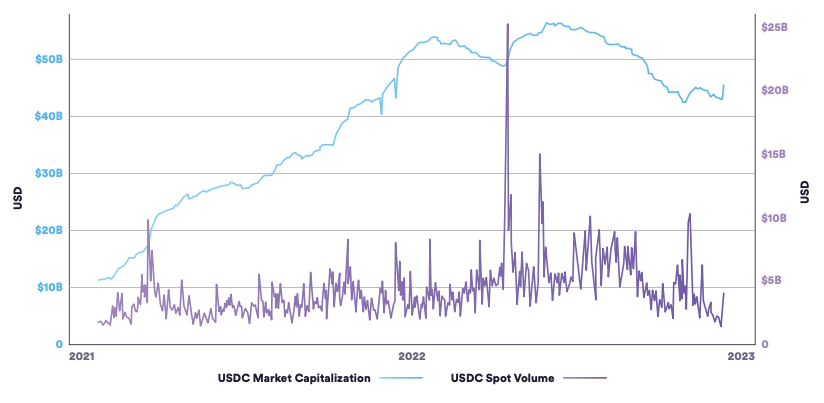
USDC Reserves
In terms of reserves, USDC is backed 1-to-1 by US dollars, with each USDC token representing a corresponding dollar held in reserve. This helps to ensure that USDC retains its value and stability, while also providing a level of transparency and accountability. In particular:
- 80% of their reserve is held in 3-month US Treasury Notes, one of the most liquid financial product in the world,
- 20% in USD, diversified among 8 US-regulated banking partners, with the banks choose based on the social impact that the deposits could have in underrepresented minorities.
However, by the end of the year, all of the cash reserves will be moved away into Circle’s Reserve Fund. The fund is, in fact, a SEC-registered money m market fund offering daily disclosures of USDC’s reserves. BlackRock will be the fund’s managers, with Bank of New York Mellow as custodian.
In other words, Circle is going all-in, partnering with the biggest sharks in the current traditional financial system.
USDC’s Regulatory Compliance
Circle’s USDC has gotten a lot attention in recent years due to its ability to provide a secure and compliant alternative to traditional fiat currencies in the digital realm. One of the key features of USDC is its commitment to regulatory compliance, which has helped it gain the trust of both consumers and institutions alike.
To be fair, I should also mention that Circle, as a US-regulated financial institution, USDC is subject to strict anti-money laundering (AML) and know-your-customer (KYC) policies. Circle also conducts regular audits and financial reviews to ensure that USDC is in compliance with all relevant regulations.
TRUST & VERITE
To address these concerns, Circle has developed a solution called TRUST (Travel Rule Universal Solution Technology). This is a technical solution that complies with the Financial Action Task Force (FATF) travel rule requirements. The travel rule, introduced by FinCEN in 1996, requires financial institutions to pass on certain information to the next financial institution, in certain funds transmittals involving more than one financial institution. The rule was enforced on crypto in October 2021.
In order to strike a balance between privacy and compliance, Circle has implemented a number of safeguards. There is no central store of personal data, and the information is only sent directly from one trusted user to another. Additionally, Circle has implemented a proof of address ownership mechanism to ensure that the sender of the funds is indeed the owner. The company has also partnered with Exiger to maintain core security and privacy standards.
Word Of Warning
However, it’s worth noting that there is no way to verify the claims made by Circle, as they remain a centralized institution with close-sourced technology. To tackle the issue of digital identity, Circle has partnered with Block, Coinbase, and other parties through VERITE. This is a decentralized and open-sourced tool for digital identity that allows for the tracking of AML, KYC requirements, accredited investor status, social reputation, NFT provenance tracking, and more, without the need for participants to disclose any personal data.
Where Is USDC Headed?
In 2023, I believe USDC will continue its growth trajectory obviously not at the same rate we have seen in 2020-2021. We might even see an IPO in 2025-2026, after their first attempt in late 2022 with a SPAC merger. In hindsight, great call. IPO in late 2022 would have been a bad idea.
Software vs Protocol
A possible modernization of the Bank Security Act can play a significant role in the future of USDC. With a distinction between software and protocol, USDC will be well-positioned to take advantage of the growing trend towards blockchain-based finance. This could see USDC becoming a key player in the development of financial crime compliance tools, technologies, and standards that promote collective defense, while keeping blockchain-based finance open and accessible.
Privacy-preserving Tech
Another trend that USDC is expected to be at the forefront of is the encouragement of the use and development of privacy-preserving technologies. While meeting financial integrity standards, norms, and protections, USDC will help to encourage and harmonize the legitimate use of digital assets and open blockchains. This will be important in promoting the growth and acceptance of digital currencies, and could be a key factor in shaping their future.
Open-source Tools
In 2023, the protection of open source software and its development is also expected to be a major focus for USDC. This will be important in ensuring that the technology remains accessible and equitable, and will help to foster innovation and growth in the digital asset space.
Finally, the development, dissemination, and normalization of the use of privacy-preserving decentralized identity and authentication is also expected to be a key area of focus for USDC in 2023. With the use of decentralized and open-sourced tools for digital identity, USDC will be able to track AML, KYC requirements, accredited investor status, social reputation, NFT provenance tracking, and more, without the need for participants to disclose any personal data.
Concerns
The relationship between USDC and the traditional financial world will play a significant role in shaping USDC’s future development. Circle has a strong dependence on maintaining a positive relationship with the traditional financial system, which may result in some sacrifices of their objectives.
Despite this, Circle remains dedicated to advancing the technology layer and empowering developers to create innovative cross-chain applications that merge the functionality of trading, lending, payments, NFTs, gaming, and more. The goal is to enable millions of developers to transform the financial system into a more open, equitable, and internet-native platform for seamless value exchange.
Final Thoughts
Low and behold, Circle’s vision for USDC is to empower millions of developers to rewire the financial system, creating a more open, equitable, and internet-native foundation for the frictionless exchange of value. With the many developments and trends expected to shape its future in 2023, USDC is set to play a key role in the continued growth and evolution of the digital asset space.
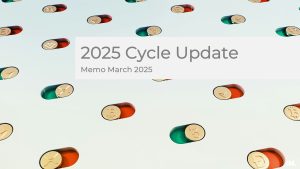
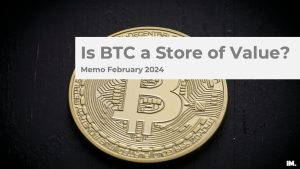
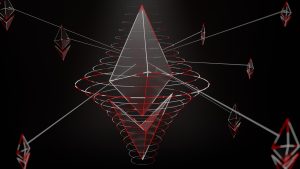

No comment yet, add your voice below!